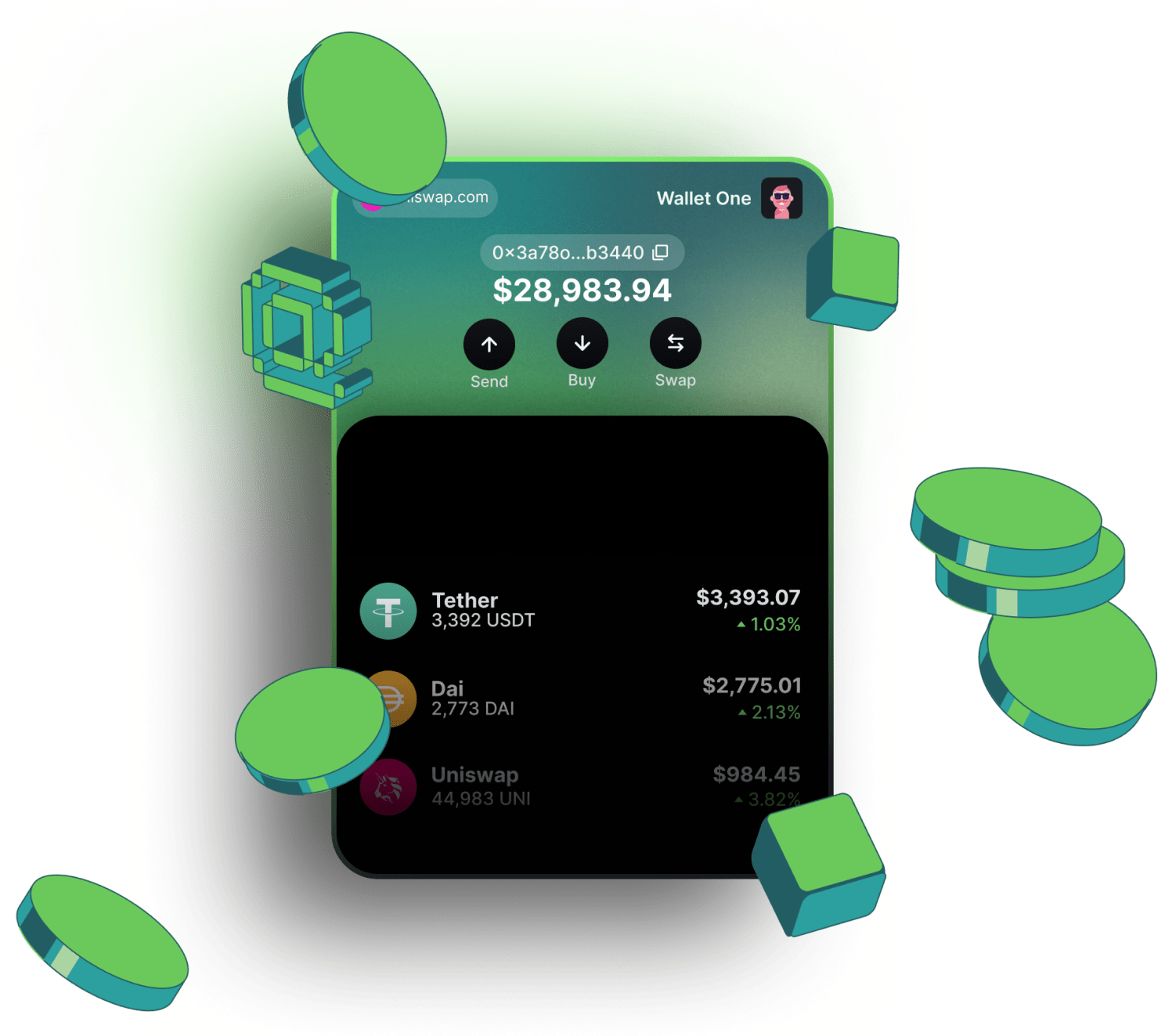Wigwam is the best  Rootstock blockchain crypto wallet
Rootstock blockchain crypto wallet

Why choose the Wigwam crypto app?
Work with Rootstock Testnets and Mainnet
Swap Rootstock tokens directly in the wallet
Buy Rootstock tokens, including the native token, by using a credit card
Ability to connect the wallet to all Rootstock blockchain dApps
How to get a Rootstock address in Wigwam web wallet
Create a wallet in Wigwam
Choose a Rootstock network from the dropdown menu
Copy you Rootstock address
How to get a Rootstock chain address in Wigwam web wallet
- Create a wallet in Wigwam.
- Click on the blockchain pop-up menu in the browser toolbar.
- Choose the “Network” dropdown.
- Select Rootstock.
- Activate the “Testnets & All” switch if you’d like to work with the Rootstock Testnet as well.
Rootstock chain review
Rootstock is an open-source, EVM-compatible sidechain that expands the possibilities of the bitcoin ecosystem. It is compatible with the Ethereum Virtual Machine (EVM), which is a green light for all developers deploying smart contracts using the Solidity language. They don't need to make significant changes to their code, they just need to deploy it on Rootstock.
Rootstock uses the DECOR+ consensus protocol, which allows it to be merged with bitcoin or any other blockchain.
Origins and Key milestones
At the time, there was a lot of discussion about which soft-for was better for bitcoin. In 2015, a group of Argentinian engineers and entrepreneurs published the Rootstock whitepaper. But the project team decided to put their ideas into practice. Rootstock brought Ethereum's smart contract capabilities to Bitcoin, making transactions more efficient for users.
However, the founders emphasize that they never intended to compete with bitcoin, it's just the way to make it more scalable and innovative.
In 2017, RootstockLabs was founded as a foundation for the future scale of bitcoin.
In 2019, the Rootstock Infrastructure Framework (RIF) was launched. This is a set of decentralized protocols that make it fast, easy and secure to build groundbreaking products and services on top of Bitcoin using Rootstock.
Rootstock main benefits
Rootstock is designed to be a universal tool for anyone who wants to take full advantage of the bitcoin ecosystem by using its upgraded version with Ethereum's smart contract capabilities.
PowPeg
One of the breakthrough features of PowPeg are hardware devices called PowHSMs. They protect private keys in such a way that transactions can no longer be signed manually. This eliminates the need for human control, and private keys cannot be extracted or backed up in any way.
In addition, PowPeg enables the whole concept of transactions between the core bitcoin platform and Rootstock possible. You simply need to send bitcoin to a special address where it is locked in the bitcoin network. The same address is also used in the Rootstock network for a user. This is called a peg-in. A user can also do the reverse (peg-out) by sending bitcoin to a special address in the Rootstock network and getting their assets back on the main bitcoin network.
Merged Mining
Rootstock offers the highest rewards paid to miners and is the #1 bitcoin merged mining platform. Bitcoin transaction fees reach ~80% for each block submitted. Moreover, according to statistics, the block time on Rootstock is about 5-6 times faster than on Syscoin, Elastos and other platforms.
In addition, miners can save a lot on equipment since they can use the same mining infrastructure they use for bitcoin to mine on Rootstock. All they need to do is set up a Rootstock node. The fees are paid by a smart contract called REMASC.
Merged mining makes Rootstock one of the most secure smart contract platforms in the world, as merging with the bitcoin ecosystem means the platform is backed by the same computing resources as bitcoin.
Rootstock Tokenbridge
The Tokenbridge is an interoperability protocol that allows you to easily move Rootstock or Ethereum ERC20 tokens between networks. It is available on Mainnet or Testnet.
How to use Rootstock Tokenbridge
- Go to the Mainnet tokenbridge page.
- Connect your wallet.
- Select a token from the list.
- Enter the amount of tokens you’d like to convert.
You will then see a disclaimer asking you to wait about 30 seconds for the transaction to be mined.
- Confirm the transaction and click Submit Transaction.
- If everything is okay, you will see a transaction in an Account Transaction section.
Note that only whitelisted tokens can be bridged. That's how Rootstock avoids malicious contracts and DDoS attacks.
How to swap tokens between Wigwam and Rootstock
- Open your Wigwam wallet.
- Choose the ‘Swap’ option in the main menu on the left.
- Choose the blockchain and the token you’d like to swap.
- Choose Rootstock and rUSDT in the second window.
- Select the amount of USDT you’d like to swap.
- Click on ‘Start Swap.’
- The system will automatically choose the best platform on Rootstock for a swap. Check all the details, including fee.
- If the fee is too high, you’ll get additional notification. Press ‘Continue’ if you’re ok with it.
- Make sure you have enough gas for the transaction. Get some ETH and then approve the transaction.
- Approve the token swap.
- Wait for the chain to prepare a bridge transaction.
- Once the transaction is finished, check your balance.
ATTENTION! Note that there may be no routes available due to low liquidity or the amount selected being too low.
You have three options: cancel the transaction, refill your account or wait for the information to be updated.
Tokenomics and gas usage on Rootstock
RBTS
RBTS is the native token of the Rootstock. It is also referred to as 'Smart Bitcoin'. RBTC is the main gas fee token that makes transactions on Rootstock seamless.
Powpeg is the pawn of security and stability of the whole system. It guarantees that one RBTC is always worth one BTC by locking bitcoins in the system with an initial hashrate that establishes consensus on the bitcoin network.
You can convert BTC into RBTC by sending BTC through the Powpeg or through decentralized exchanges.
RIF
RIF is the native token of the built-in RIF ecosystem that implements fintech products in the bitcoin ecosystem.
It's the main driver of the entire infrastructure. It can also be used as a gas fee for RIF Relay, a secure sponsored transaction system where users can pay transaction fees with ERC-20 tokens. This eliminates the need to hold Rootstock's native token, RBTC.
FAQ
RBTC is the main gas fee token that makes transactions on Rootstock seamless.
Enter your public wallet address into the search bar on Rootstock Explorer page and get all your transaction history, statistics and other details.
To view stats, go to the Rootstock Stats page. Here you can check the average block duration and the merged mining hash rate. You can also check the most important metric, which is the average block time (approximately 33 seconds).
There are many wallets that support RBTC and RIF tokens, including MetaMask, Ledger Nano, Wigwam web3 wallet, MyEtherWallet, MyCrypto and many more. Check the full list here.
- Open MetaMask extension.
- In the network selector (top right corner), choose Custom RPC.
- Fill in the following values:
Field RSK Mainnet
Network Name: RSK Mainnet
RPC URL: https://public-node.rsk.co
ChainID: 30
Symbol: RBTC
Block explorer URL: https://explorer.rsk.co
Rootstock's most popular projects are Money On Chain, BabelFish, Symbiosis, Sushiswap V3, Uniswap V3, Liquality.